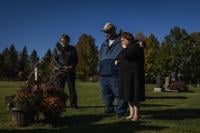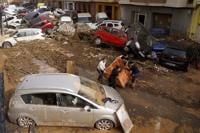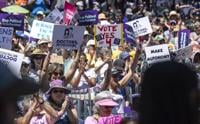DEIR AL-BALAH, Gaza Strip (AP) — Thousands of Palestinian families fled Wednesday from the brunt of Israel’s expanding ground offensive into Gaza’s few remaining, overcrowded refuges, as the military launched heavy strikes across the center and south of the territory, killing dozens, Palestinian health officials said.
On foot or riding donkey carts loaded with belongings, a stream of people flowed into Deir al-Balah — a town that normally has a population of around 75,000. It has been overwhelmed by several hundred thousand people driven from northern Gaza as the region .
Because U.N. shelters are packed many times over capacity, the new arrivals set up tents on sidewalks for the cold winter night. Most crowded onto streets around the town’s main hospital, Al-Aqsa Martyrs, hoping it would be safer from Israeli strikes.
Still, no place is safe in Gaza. Israeli offensives are crowding most of the population into Deir al-Balah and Rafah at the territory’s southern edge as well as a tiny rural area by the southern coastline. Those areas continue to be hit by Israeli strikes that regularly crush homes full of people.
Israel has said its campaign in Gaza is likely to last for months, vowing to dismantle Hamas across the territory and prevent a repeat of into southern Israel. Benny Gantz, a member of the country's three-man War Cabinet, said the fighting ”will be expanded, according to need, to additional centers and additional fronts.”
He and other Israeli officials also threatened greater military action against Lebanon’s Hezbollah, hiking fears of an all-out war on that front.
The two sides have exchanged fire almost daily across the border. Israeli Foreign Minister Eli Cohen warned Wednesday that “all options are on the table” if Hezbollah does not withdraw from the border area, as called for under a 2006 U.N. cease-fire.
Hezbollah leader Hassan Nasrallah “must understand that he’s next,” Cohen said.
DEATH, DISPLACEMENT AND STARVATION
Israel's offensive in Gaza has already been one of the in recent history. , most of them women and children, have been killed, according to the Health Ministry in Hamas-ruled Gaza. The count doesn’t differentiate between civilians and combatants.
Some 85% of Gaza’s population of 2.3 million people have fled their homes. U.N. officials say a quarter of Gaza’s population is starving under Israel’s siege, which allows in only a trickle of food, water, fuel and other supplies.
The latest people to be displaced fled from several built-up refugee camps in central Gaza targeted in the latest phase of Israel's ground assault. One of the camps, Bureij, came under heavy bombardment throughout the night as Israeli troops moved in.
“It was a night of hell. We haven’t seen such bombing since the start of the war,” said Rami Abu Mosab, speaking from Bureij, where he has sheltered since fleeing his home in northern Gaza.
The Israeli military issued evacuation orders for Bureij and neighboring areas Tuesday. The area was home to nearly 90,000 people before the war and now shelters more than 61,000 displaced people, mostly from the north, according to the U.N. Bureij camp, like others in Gaza, houses refugees from the 1948 war surrounding Israel’s creation and their descendants and now resembles other densely populated neighborhoods.
It was not known how many were evacuating. In Deir al-Balah over the past two days, empty lots have filled up with families in tents or sleeping on blankets on the ground.
This was the third move further south for Ibrahim al-Zatari, a daily laborer. First he, his wife and four children moved in with relatives in Gaza City after a strike flattened their home in northern Gaza. Later, they fled to Bureij to escape fighting in the city. On Wednesday morning, they made an hourslong journey on foot to Deir al-Balah, where — like many others — they wandered the streets looking for an empty spot to lie down.
“There is no foothold here,” he said. “Where should we go?”
With much of northern Gaza leveled, Palestinians fear a similar fate awaits other areas, including Khan Younis, where Israeli forces launched ground operations in early December. The Israeli military said Wednesday it deployed another brigade in the city, a sign of the tough fighting.
Israeli shelling Wednesday struck a residential building in Khan Younis next to Al-Amal Hospital, according to the Palestinian Red Crescent, which runs the facility.
Health Ministry spokesman Ashraf al-Qidra said at least 20 people were killed and dozens more wounded. Footage from the scene showed several torn bodies lying in the street as rescue workers loaded a man whose legs had been severed onto a stretcher.
Despite U.S. calls for Israel to shift to a more precise assault, the military so far appears to be following the same pattern used in earlier phases of the ground offensive in northern Gaza and Khan Younis. Before troops move in, heavy bombardment targets what Israel says is Hamas’ tunnels and military infrastructure. Fierce urban fighting follows as troops move block to block, backed by airstrikes and shelling that the military says aim to force out pockets of militants. The resulting devastation has been massive.
Israel has said Hamas must be destroyed after its in which militants broke through Israel’s formidable defenses and killed some 1,200 people — mostly civilians — and abducted around 240. An estimated 129 remain in captivity after dozens were freed.
Israel blames Hamas for the high civilian death toll in Gaza because the militants operate in residential areas. Late Wednesday, the army said it destroyed a network of tunnels that stretched for several kilometers in Gaza City and served as a command and control center. Part of it ran under a hospital and had an exit inside a neighboring school, it said.
The military says it has killed thousands of militants, without presenting evidence, and that 164 of its soldiers have been killed in the ground offensive.
WARNING OVER LEBANON
Cross-border exchanges of fire have escalated between Hezbollah and the Israeli military.
An Israeli strike on a family home in Lebanon overnight killed a Hezbollah fighter, his brother and his sister-in-law, local officials and state media said Wednesday. A day earlier, a Hezbollah strike wounded 11 people in northern Israel.
Since the Gaza war began, the near daily battles have forced tens of thousands of Israelis to evacuate their homes from nearby communities. At least nine soldiers and four civilians have been killed on the Israeli side, and around 150 people on the Lebanese side, mostly fighters from Hezbollah and other groups, but also 17 civilians.
Gantz warned that time for diplomatic pressure was “running out.”
"If the world and the Lebanese government will not act to stop the firing on the northern settlements and keep Hezbollah away from the border, the IDF will do so,” he said, referring to the Israeli military.
In the occupied West Bank, Israeli forces killed at least six Palestinians during an overnight raid in the refugee neighborhood of Nur Shams, according to the Palestinian Health Ministry. More than 300 Palestinians have been since the start of the war, mostly in confrontations with Israeli forces during raids and protests.
___
Magdy and Keath reported from Cairo. Associated Press writer Najib Jobain contributed from Rafah, Gaza Strip.
___
Find more of AP’s coverage at














































